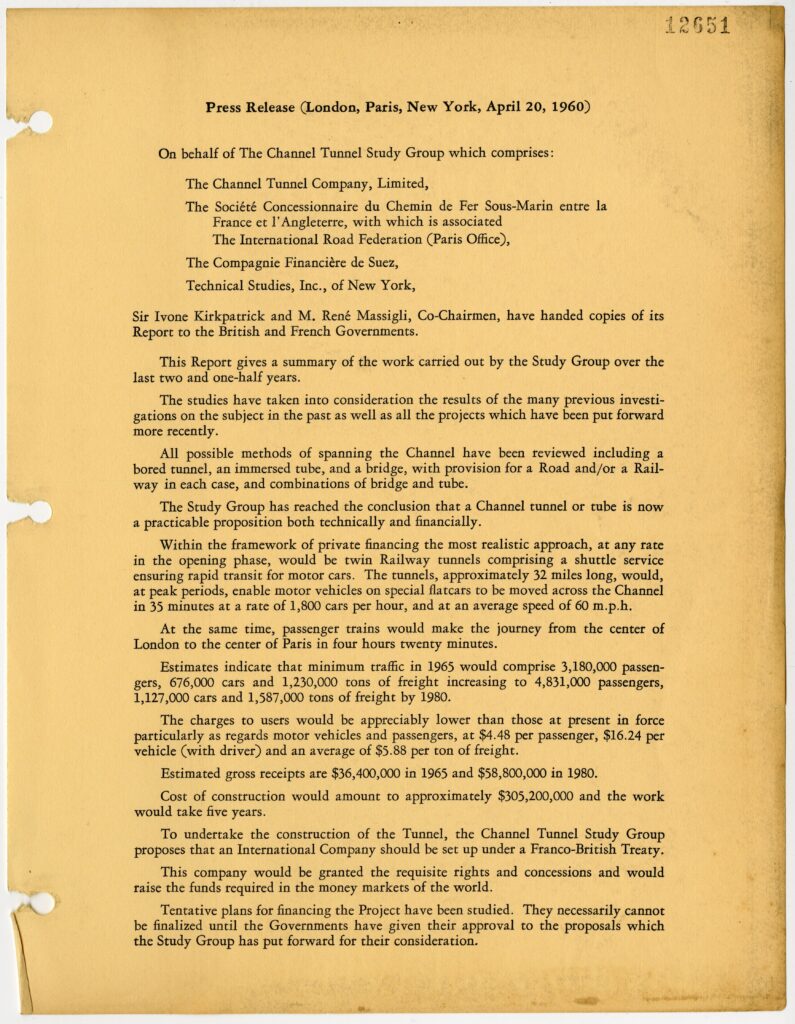Members of the Channel Tunnel Study Group carried out detailed geological and economic studies into the feasibility of the “Chunnel” from the 1950’s onwards. A selection of their work, which paved the way for it to open in May 1994, is on display at the University of Exeter to mark the Channel Tunnel’s 30th birthday.
The exhibition – entitled ‘Sir Harold Harding’s Chunnel Vision’ – features a range of items kept by the civil engineer, Sir Harold Harding, collected when he was joint consultant, with René Malcor, to the Channel Tunnel Study Group between 1958 and 1970.
The University of Exeter holds Sir Harold’s professional papers, which include reports, photographs, lantern slides and prints relating to exploratory works and investigations for a Channel Tunnel and Piccadilly Circus.
Many of the documents in the collection consist of Sir Harold’s copies of reports compiled by the Group, which provide fascinating insight into their investigations and studies. For example, a report to the Delegate of the Group, dated around 1960, shows the variety of considerations taken into account by the Group, including the works for boring twin rail tunnels, possible revenues, tourism statistics, ventilation, and even claustrophobia.
Another volume, entitled Persons & Organisations of Interest in Connection with the Channel Tunnel Project’, includes a press release of the Channel Tunnel Study Group, which announces the submission of the Group’s report – concluding that “a Channel tunnel or tube is now a practicable proposition both technically and financially” – to the British and French government in 1960.
The volume also includes a map of the planned tunnels, as well as a biography of every person and organisation involved in the investigations between 1958 and 1960, including a biography of Harold Harding.
There are a number of fascinating photographs in the collection relating to the Study Group’s investigations in the late 1950s. These include photographs of a pumped-out shaft at Sangatte, France, which had originally been bored in 1882, as well as geological investigations of the lower chalk level of the earth’s core near the English shore. There are also a series of photographs of marine borings and sea bed investigations by Wimpey Central Laboratory for the Channel Tunnel Study Group.
In addition, Sir Harold kept several different publications relating to the Channel Tunnel, including articles published in journals and newspapers; leaflets educating the public on the benefits of a Channel Tunnel; and a report on the Tunnel presented to Parliament in 1973 by the Secretary of State for the Environment.
The exhibition has been created by Special Collections archivist Annie Price with the assistance of student volunteer Vanessa Wong. It is open to everyone and is expected to remain on display until summer 2024 in the Forum Library on the Streatham campus.
The Channel Tunnel Study Group was formed in 1957 to research the engineering and economic possibilities of a Channel Tunnel. Sir Harold was one of the key consultants to the Group. He and Rene Malcor led the investigations, which included boreholes on land, a geophysical survey, and pumping out and examining the experimental shaft at Sangatte in 1958, as well as an investigation of seabed conditions by Wimpey Central Laboratory in 1959.
The Channel Tunnel Project was abandoned in 1975, but interest in a fixed cross channel link continued. The final deal was legally agreed in 1986.
Image credit: University of Exeter



